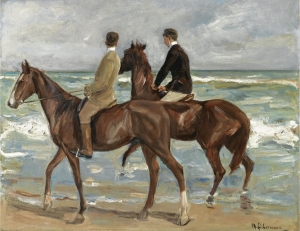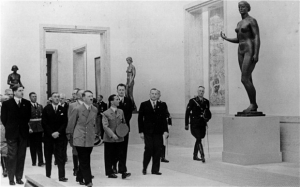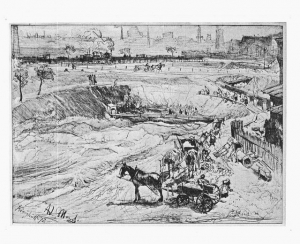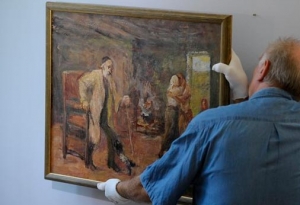|
Displaying items by tag: Max Liebermann
Three years after German authorities uncovered a vast collection of one of Adolf Hitler’s main art dealers, the first artwork restituted from the trove will head to auction next month.
On June 24, Sotheby’s in London will ask between $540,000 and $850,000 for Max Liebermann’s “Two Riders on a Beach,” a 1901 scene of two elegantly dressed men riding chestnut-colored horses beside a surf.
A court handling the late art collector Cornelius Gurlitt's inheritance says it has formally authorized the return of the first two paintings from his trove to their rightful owners' descendants.
The Munich district court said Tuesday it approved the handover of Henri Matisse's "Woman Sitting in an Armchair" and Max Liebermann's "Two Riders on the Beach" after both potential heirs to Gurlitt's collection endorsed the move.
Kunstmuseum Bern (Museum of Fine Arts Bern), Switzerland has agreed, today, to accept artworks from the collection of Cornelius Gurlitt's 1,300 works that has been bequeathed to the museum by German collector. Christoph Schaeublin of the Bern Art Museum told a news conference in Berlin that the museum would accept parts of the artworks bequeathed by Cornelius Gurlitt, who died in May at the age of 81.
The collection has been known colloquially as the “Munich Art Trove,” and collated by Cornelius Gurlitt’s father, Hildebrand Gurlitt. Gurlitt senior was one of four art dealers entrusted with selling so-called degenerate art during the Nazi regime’s rule. The collection includes a number high-value works from the period by Henri Matisse, Max Liebermann, Otto Dix, and Marc Chagall, among others. Originally estimated at the value of nearly £700 million - the value has dropped significantly as many pieces are believed to have been looted from Jewish families by the Nazis.
Jewish World Congress president Ronald Lauder has publicly threatened the Kunstmuseum Bern with an "avalanche" of lawsuits if the institution accepts the collection of approximately 1,300 artworks bequeathed to it by the late Cornelius Gurlitt - stated in an article published by German weekly "Der Spiegel." The museum is currently still in the process of making this delicate decision - whether or not to accept the collection - which includes works by Henri Matisse, Max Liebermann, Otto Dix, and Marc Chagall, among others famous artists.
Gurlitt died on May 6th of this year, leaving the entire collection to the Swiss museum - but nearly 600 works from the collection are suspected to be of questionable provenance, possibly Nazi loot.
German government-appointed experts on Friday gave the green light to the restitution of one of the most valuable artworks in the trove of late collector Cornelius Gurlitt to its American owners.
Art experts mandated by Berlin to comb Mr. Gurlitt's collection for Nazi loot said that "Two Riders on the Beach," a 1901 Max Liebermann painting, was looted during World War II and rightfully belonged to the heirs of David Friedmann, a German-Jewish collector who died in the early 1940s. The family is currently suing the Bavarian government for its return.
German Nazi-era art hoarder Cornelius Gurlitt, who died on Tuesday, has made the Bern Art Museum in Switzerland his "sole heir".
The reclusive son of Adolf Hitler's art dealer is estimated to have amassed a collection worth up to a billion euros.
The museum said the news struck "like a bolt from the blue", given that it had had no relationship with Mr Gurlitt.
The collection was the subject of a long legal dispute over works that may have been taken illegally by the Nazis.

David Toren, a retired lawyer from New York, has filed a lawsuit against Germany for the return of artwork in the case surrounding Cornelius Gurlitt. Gurlitt, the son of the German art dealer Hildebrandt Gurlitt, is accused of hoarding hundreds of masterpieces stolen by the Nazis.
Toren is asking for the return of Max Liebermann’s “Two Riders on the Beach,” as well as any other works belonging to his family in the Gurlitt trove. The Liebermann painting, which was owned by Toren’s great Uncle, David Friedmann, was one of the first paintings made public when Gurlitt’s trove came to light. Toren filed the lawsuit in U.S. district court in Washington against the federal republic of Germany and the free state of Bavaria. The suit claims that the German government is retaining property that it doesn’t own and demands that authorities return the Liebermann canvas to Toren and pay unspecified damages.
Out of the 1,406 paintings in Gurlitt’s trove, about 970 are suspected of being looted from Jewish families or taken from museums during World War II. Gurlitt’s father was put in charge of selling stolen artworks abroad by Joseph Goebbels, Hitler’s Minister of Propaganda, but secretly hoarded many of them and later claimed that they were destroyed in the bombing of Dresden. Gurlitt, who is unemployed, sold a number of the paintings over the years and lived off of the profits.

The German government has released some details about the astounding art collection found in a dilapidated Munich apartment. Authorities released a written statement saying that about 590 of the 1,400 artworks could have been stolen by Nazis and identified 25 of the pieces on the website www.lostart.de. Among the paintings listed on the site were Otto Dix’s The Woman in the Theater Box, Otto Griebel’s Child at the Table and Max Liebermann’s Rider on the Beach. The trove also includes works by Henri Matisse, Marc Chagall and Pablo Picasso.
The masterpieces were found in the apartment of Cornelius Gurlitt, the son of the art dealer Hildebrandt Gurlitt, who reportedly acquired the works in the late 1930s and 1940s. Gurlitt’s father had been put in charge of selling the stolen artworks abroad by Joseph Goebbels, Hitler’s Minister of Propaganda, but secretly hoarded many of them and later claimed that they were destroyed in the bombing of Dresden. Gurlitt, an unemployed recluse, sold a number of the paintings over the years and lived off of the profits. 200 of the pieces have outstanding return requests from the original owners’ heirs.
The German government has assembled a task force of six experts to research the provenance of each recently discovered artwork. To date, it has been determined that one painting by Matisse was stolen by the Nazis from a French bank in 1942.
German officials will update the Lost Art website regularly as the investigation progresses.

The great-granddaughters of the German-Jewish painter Max Liebermann are growing impatient with Berlin museum authorities about two drawings from his collection they say were lost as a result of Nazi persecution.
The drawings by Adolph Menzel in the Kupferstichkabinett in Berlin are among thousands of works that Liebermann’s heirs are trying to recover. Liebermann was not only one of the most famous German Impressionists; he was also a great collector. Works by Edouard Manet, Edgar Degas, Claude Monet and Auguste Renoir adorned his imposing home next to the Brandenburg Gate.
Forced to resign as honorary president of the Prussian Academy of Arts after the Nazis took power, Liebermann died isolated and embittered in 1935, leaving his estate to his widow. She sold some artworks to pay the rent and buy food and medicine before committing suicide in 1943.
“For the heirs, it’s difficult to understand why public institutions are so hesitant,” said Georg Castell of Heinichen Laudien von Nottbeck Rechtsanwaelte in Berlin, the lawyer representing the great-granddaughters. “Without cooperation from the museums, we can’t get very far.”

Israel’s national museum said Thursday that it has returned a painting to the estate of its creator, decades after the masterpiece was looted from a Jewish museum in Nazi Germany.
The Israel Museum said “The Return of Tobias,” a 1934 painting by German Jewish artist Max Liebermann, is now in Berlin after it was determined the work belongs to Liebermann’s heirs.
Liebermann, who died in 1935 at the age of 88, was a prolific painter who led the avant garde artistic society known as the Berlin Secession. He also served as president of the Prussian Academy of Arts during the 1920s and early 1930s. Some of his works have been valued at more than $1 million.
The Israel Museum’s director, James Snyder, said Liebermann loaned his painting to the Jewish Museum in Berlin in the 1930s. The work, along with many others, disappeared from the museum during World War II. German Nazis stole countless art treasures from museums across Europe.
After the war, the American-initiated Jewish Restitution Successor Organization searched for stashes of stolen art and distributed those pieces with no known heirs to Jewish institutions worldwide.
Liebermann’s painting was one of more than 1,000 such works delivered to Jerusalem’s Bezalel National Museum, the precursor to the Israel Museum, in the 1950s.
Over the last year, art historians began delving into the background of the painting while preparing for an exhibit on looted art in the Berlin Centrum Judaicum, Snyder said. Liebermann’s work was one of 12 pieces the Israel Museum agreed to send to Germany for the exhibit.
The research determined the piece was originally a loan from the artist — and therefore should be returned to his heirs. While “The Return of Tobias” was originally due to stay in Berlin for the three-month exhibition beginning this month, the piece will remain in Germany with his family.
|
|
|
|
|